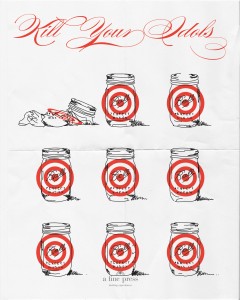Do you ever feel pressure to be original?
If I can be frank, I’m kind of sick of that word…original. There’s so much pressure to summon the muse, to conjure from nothing groundbreaking thoughts and sights.
I call BS.
If these are examples of plagiarism, then we want more plagiarism. – Jonathan Lethem
It seems like there are plenty of event professionals out there that have read the Ecclesiastical memo: There is nothing new under the sun. Austin Kleon‘s excellent book Steal Like an Artist opens with this permissive credo. If it’s impossible to truly create ex nihilo, then we’re free to borrow and repurpose as we see fit.
I don’t disagree with this, but methinks many of my colleagues have stopped there.
 I posted this image a couple of days ago, hoping to incite some form of passionate conversation. Perhaps you’ll join the conversation in the comments below. Yes, it’s an obvious reference to a waning trend, but I believe it serves its point: just because you’re free from being truly “original” doesn’t mean you’re free to be a bore.
I posted this image a couple of days ago, hoping to incite some form of passionate conversation. Perhaps you’ll join the conversation in the comments below. Yes, it’s an obvious reference to a waning trend, but I believe it serves its point: just because you’re free from being truly “original” doesn’t mean you’re free to be a bore.
Pinterest is great, but what (if anything) are you doing with all those pins? Are you simply making facsimiles of someone else’s work (which they inevitably nicked from some other dark recess of the internet – or a neighbor) or are you remixing, collaging and making it your own?
In Steal…, Kleon mentions a fascinating article from the February ’07 issue of Harper’s. In it, Jonathan Lethem extols the virtues of many a great plagiarist who were savvy enough to shroud their source material in the veil of yet other sources, remixing through the filter of their experiences until their audience had no choice but to perceive the work as “original.” Kleon characterizes Lethem’s stance by saying “when people call something “original,” nine out of ten times they just don’t know the references.”
So this is my call: start appropriating from sources a little lower to the ground. Find inspiration outside the world of weddings or design. Absorb the work of someone you love and root out its essence – who did they love? Search for your creative grandparents and work your way up that family tree.
It’s OK to cop to not being “original.”
Nobody truly is.
But, please, do the world (and your muse) a favor and scratch a little deeper than the surface.
I think there is such a fetish for “originality” now. There’s such a desire to be that one special snowflake that re-invents the real because that’s what we we’ve been raised to do. We root for the underdog because we view ourselves as it and that is a dream most of us try to base our careers around. That mindset is a bit dated and optimistic at best, and I feel that if you can’t take a look around and find the inspiration, their work has failed. Their work has failed to spark something in you. There shouldn’t be a shame in taking a look at the world and digging past the obvious. Googling “creative business cards” when needing a nifty business card is nice but as you said, there is so much more out there to grasp at.
I use Pinterest as a catalog of good to great. I use it as a measurement of what to aspire to and what to take inspiration from. It’s a Frankenstein’s monster that roots itself in my work. But, at the end of the day, it’s my hands and mind making something. Research and inspiration can get you to the starting line, but it is up to you to run that race.
As a designer, I’ve beat myself up multiple times over not being “original” enough. But in the real world with deadlines, bills to pay, and migraines, I agree – it’s okay to not feel that way!
Oh god, typos galore. Last time I do this in a rush. 😛
I’ve been thinking a great deal lately about the “how would inspiring artist x do it” exercise. How would Damien Hirst design this business card? How would Michael Graves approach this invitation?
It doesn’t always yield passable results on its own, but is almost always a step in a new and interesting direction.
Because that approach isn’t copy and paste then switch the color palette or tweak a few things. It’s not necessarily getting inspiration from ONE specific business card on google, it’s thinking of the theories and style that a specific designer has created. We should take inspiration from people and their design theory, not just one item they produce!
What does “original” even mean? Lack of sources? Completely from scratch? The fact that we have memories means we can’t be original. Purposeful creation is an act of skill, of some learned thought process or muscular movement or directed energy or or balancing act of judgement or even erasure of mistake. Decisions. They’re ALL forks in a road. Left or right. High or low. Black or white. And most of the time there are a million forks at the same time. First or Last.
Couldn’t you make an EXACT copy of something for a completely different reason?
In the field of physics there is something called the observer effect. It states that the meer measurement of a phenomenon (experience, matter, energy, space, time, motion, event) changes the phenomenon.
Even if you make a xerox of something doesn’t it fade the original?
Can’t a copy be better than an original?
Isn’t everything original?